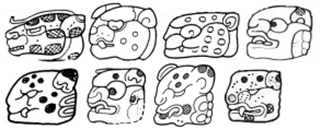![]()
![]()
![]()
![]()
![]()
K&H.p80.#6 TOK.p31.r5.c1 BMM9.p17.r4.c1 25EMC.pdfp30.#4.1 = JM.p42.#1 Grube-WwH.p170.fig3.b
BALAM BAHLAM BALAM BALAM BALAM BAHLAM

![]()
K&L.p11.#1 [25EMC.pdfp30.#4.2 = K&L.p11.#1.5] 25EMC.pdfp30.#4.3&4
BALAM
· Features:
o One or two fangs.
o Mammal ear, sometimes distinctly “pear-shaped”.
o Jaguar spots.
o Optional “darkness” in the lower part / back of the head.

Martin
“Randel” Stela J9
ba.<la:ma> or ba.<<HA’[la]>:ma>
· From context, this glyph-block must be the word bahlam. It’s the first part of the name of the main protagonist, Bahlam Chik Uy, and elsewhere, the first part is written unambiguously with the BAHLAM (e.g. at E1), and the rest of the name matches.
o Structure:
§ J9a is obviously ba and uncontroversial.
§ The top of J9b is probably la (with the expected “upside-down la-face”).
§ The bottom of J9b is probably ma (the “bow-tie” / “butterfly” variant).
However, the “blades of grass” at the bottom of “la” are very unusual. Could this be ma instead, and the bottom element a very unusual form of la – i.e. ba.<ma:la>? Unlikely, as the ma has a right-side up face, and this one has upside-down face. Furthermore, there are no variants of la with a rectangular/squarish element in the middle, and “mirror-image” elements on both sides – this really must be ma. Lastly, there is no reason to invert the usual order ba-la-ma to ba-ma-la.
o Two possible explanations (both very unlikely):
§ Mora-tHIofRS.p21.para7 offers a very interesting explanation: he posits ba.<<ha[la]>:ma> è ba-h(a)-la-m(a) è bahlam. However, this explanation is unlikely, as there are only two known variants of ha: a) the head variant – with a “knot” and a skull (with infixed AK’AB), and b) the tooth variant – with an oval element containing three tiny dots at the top left (outside the main outline) and a partitive disk (inside the main outline). The element in the top 2/3 of J9b has none of these features and is hence very unlikely to be ha.
§ An even more far-fetched explanation is that the “blades of grass” somehow come from HA’ (with infixed la and ma underneath: ba.<<HA’[la]>:ma>). This proposal is extremely unlikely as HA’ has a final glottal stop, and would not be used in this way.
o One of the most striking aspects of the Classic Maya writing system is the fact that it never wrote “internal aspirated vowels”. It wrote aspirated vowels at the ends of words (e.g. baah < ba-hi)) but it never wrote pure internal ones (as in bahlam, chapaht, nahb, etc). These ones are known exclusively through linguistic reconstruction, based on the modern forms, never from the syllabogram spelling.
o There is hence no reason to think that in this one instance, the scribe attempted to capture the fact of an internal -h- using either a ha or a HA’. The “blades of grass” remain a curious unexplained aspect – perhaps just a one-off whim of the scribe.
· It was said at MotT2020 that no pure syllabogram spellings exists, and that ba-la-ma is an invention of (some) Maya epigraphers, for didactic purposes. This is perhaps one of the very few instances where the word bahlam is written purely in syllabograms. In fact, an MHD search in “Classic - Blocks” on “blcodes contains ba la ma” gives 6 hits, almost all of them indisputably ba-la-ma.